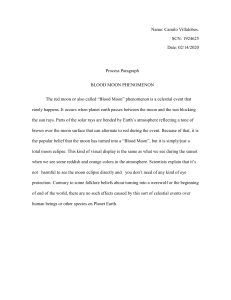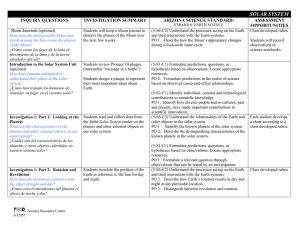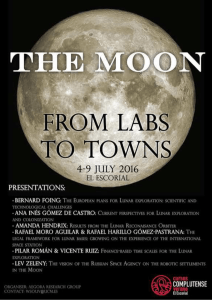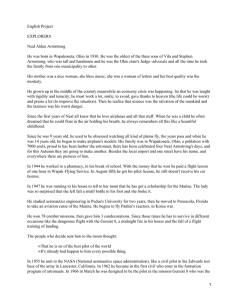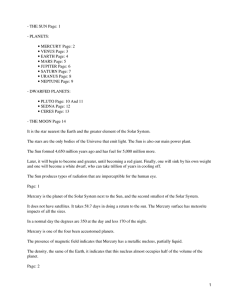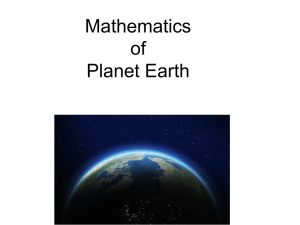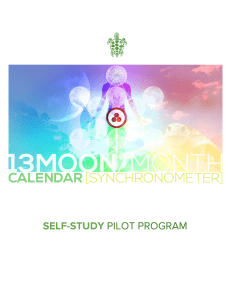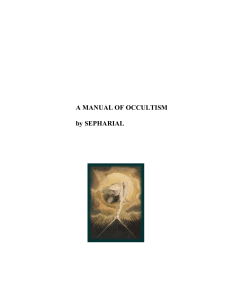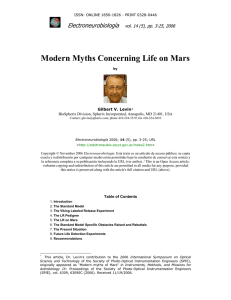The Solar System
Anuncio
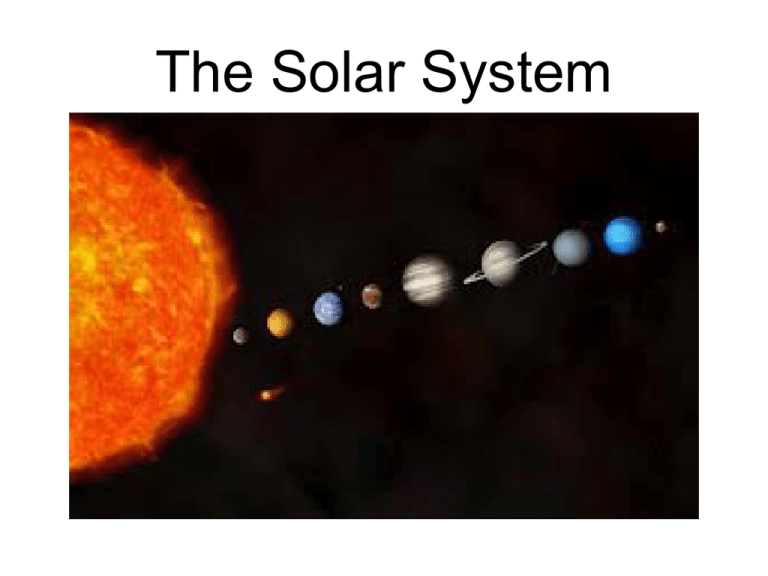
The Solar System The Solar System within the Milky way Composition of the Solar System The Solar System is composed by the Sun and the celestial bodies that orbit it in ellipses: • Planets • Satellites • Comets • Asteroids • Meteors Celestial bodies’ movements Rotation Is the spinning of a star (s. l.) on its own rotation axis Day and night Revolution Is the movement of a star (s. l.) surrounding a bigger one Makes seasons The ecliptic Also called Ecliptic Plane, it is the imaginary plane where the Earth’s orbit is. The constellations of the Zodiac lie along the ecliptic. The Sun Sun’s identity card • The closest star to the Earth • Surface temperature: 6 000 ºC • Mean distance to Earth: 149 000 km • Diameter: 1 392 000 km • Hydrogen (73 %), helium (25 %) Solar protuberances • Also called Solar Prominences • Large, bright tongues extending outward from the Sun’s surface • Often loop-shaped • Top length = 800 000 km • Maybe caused by thermonuclear reactions Size comparison among The Earth, Jupiter and a Solar Protuberance The eight Planets Inner planets •Mercury •Venus •The Earth •Mars Also called Rocky Planets, they are closer to the Sun. Outer planets •Jupiter •Saturn •Uranus •Neptune The gas giant planets, beyond the Asteroids Belt. Made up of hydrogen, helium and other gases. They have rings and many moons. The Inner Planets Mercury • 1 orbit = 88 days • 1 rotation = 59 days • • • • • No moons Closest to the Sun Little air Moon-like surface Surface temp = -170 ºC to 430 ºC • Rocky with iron core Venus • Orbit = 225 days • Rotation = 243 days • No moons • CO2 and clouds of H2SO4 • No water • Hottest planet • Retrograde (clockwise) rotation • Rocky with iron core The Earth • Orbit = 365 days • Rotation = 1 day • 1 Moon • Atmosphere, hydrosphere and geosphere • Life! • Rocky with iron core • The blue planet (oceans) Mars • Orbit = 687 days • Rotation = 25 hours • Moons: Phobos and Deimos • Polar icecaps • Valleys and canyons. Liquid water weather? • Atmosphere = CO2 • The red planet (red iron oxide) Water on Mars Ice cap on Mars’ North Pole, as seen from Viking 1 space probe • Mars has got ice caps • The North Pole ice cap is made up of extremely pure water • In South Pole ice cap there is a small portion of CO2 • CO2 frost deposits in winter and sublimes in spring Mons Olympus The highest mountain in Solar System is Mons Olympus (25 km high), on Mars Mars’ surface Seen from space probe Mars pathfinder Wings to imagination Is there a human figure on Mars? The Outer Planets Jupiter • Orbit = 12 years • Rotation = 10 hours • 16 moons (Callisto, Ganymede, Europa, Amalthea, Io) • 3 rings • Covered by coloured bands of thick clouds The largest storm we can imagine Jupiter’s Great Red Spot is believed to be a so great anticiclonic (high pressure) storm, that three Earths would fit within its boundaries. It has been observed by astronomers for the last 400 years. Saturn • Orbit = 29.5 years • Rotation = 11 hours • 30 moons • Thousand of rock and ice rings • Wind speed = 500 m/s • Yellowish surface Uranus • Orbit = 84 years • Rotation = 17 hours • 22 moons • 11 rings • Very tilted rotation axis • Blue surface • The coldest planet Neptune • Orbit = 165 years • Rotation = 16 hours • 8 moons • 4 rings • Great Dark Spot storm area Pluto, the no-more planet Discovered in 1930 by Clyde Tombaugh, it was considered a planet until 2006. Now, it has been demoted to a planetoid, despite to have its own satellite, Charon. • Its ecliptic is 17 º tilted away from the other eight planets’ • It hasn’t swept its orbit out, since it passes through Kuiper Belt Pluto’s ecliptic is deviated 17 º from the average Solar System’s The Moon Moon’s identity card • The Earth’s only natural satellite • Mean distance to Earth: 384 400 km • Diameter = 3 476 km • Tempeature: -180 ºC to +110 ºC • Non self-luminous The Moon phases • The Moon’s shape appear to change because of its revolution around the Earth • The Moon phases are produced by the alignment of the Moon and the Sun in the sky • The lit side of the Moon always points to the Sun The Spanish Moon is a liar: when in waxing crescent (creciente) it seems a letter D. When in waning crescent (menguante or decreciente), it seems a C. Why do we always see the same face of the Moon? Because the Moon rotates on its axis (red arrows) every 28 days and completes an orbit around the Earth in the same time. Explanation for children (and not so children) • Three students needed (two actors and one audience) • One actor stars the Earth; the other one, the Moon • The Earth starring will stand, no walking, rotating on himself, slow for not feeling sick. • The Moon starring will walk sideways around the Earth actor, always looking at him, preventing he to see her back, her dark side • The Moon starring doesn’t think she has rotated on her axis, since everything she has done is walk facing the Earth • But the audience, out of the performance, realizes that the Moon has really rotated an entire turn on herself at the same time she has orbited the Earth, because he has seen her face and her back But there is a real dark side of the Moon… …that was photographed for the first time on October 7th, 1 959, from the Soviet space probe Luna-3. The Moon hasn’t got an atmosphere • The Moon’s so little weight makes it does not have gravity enough to retain gases and form an atmosphere • Craters caused by meteors collisions will stay unchange for ever since there is no wind or rain to weather them Man on the Moon That’s one small step for man, one giant leap for mankind On July 20, 1 969, at 20:18 UTC, in the frame of Apollo 11 mission, the Eagle lunar module landed on the Moon. Six hours later, the mission commander, Neil A. Armstrong, and the pilot Edwin Buzz Aldrin, Jr. stepped for the first time our satellite’s surface. Michael Collins, meanwhile, orbited the Moon with the spacecraft, waiting for his companions to come back on board and take them all back home, to Earth. Moon’s landing conspiracy theories • There’s no air on the Moon. Why is the flag flapping? • Astronaut and spaceship shadows’ don’t match • There are no stars on the background Not only planets Asteroids Comets Meteors Asteroids Rocky celestial bodies that orbit the Sun. Its size can vary from little stones to dwarf planets. Asteroids are distributed in three areas within Solar System: • Asteroids Belt • Kuiper Belt • Oort Cloud The Asteroids Belt • Situated between Mars and Jupiter • Houses 90 % of Solar System’s asteroids • Thought to be a planet destroyed because of a collision The Kuiper Belt • Situated beyond Neptune • Responsible for Pluto’s demotion to planetoid The Oort Cloud Comets • Celestial bodies made up of ice, dust and gases • Mostly coming from Oort Cloud • Elliptical orbits around the Sun • Non self-luminous, but reflect the Sun light Structure of a comet Nucleus Frozen water and gases. When melting, it forms coma and tail Coma Giant cloud of dust and gases, surrounding the nucleus Tail Electrically charged gases and dust. Always pointing away from the Sun Some historical comets • Great Comet of 1882. The brightest comet in modern History. Waiting again for him in 2642 • Great Comet of 1843. The longest tail: 300 million kilometres. Period = 737 years • Halley. Registered since 240 BC. In 1910, the Earth passed throuhg its tail • Hale-Bopp. In 1995, its two tails were visible with a naked eye • Hyakutake. 1996 Two-tailed Hale-Bopp Three-tailed Donati (1858) Anti-tailed Arend-Roland (1956) Was the Star of Bethlehem a comet? The Florentine painter Giotto di Bondone, who was a witness of Halley Comet in 1301, painted The adoration of the Magi, where the Christmas Star is shown as a comet. Several efforts have been made in order to link the Star with inusual astronomical events, such as comets, supernovae or an extraordinary conjunction of Jupiter and Saturn. Tom Sawyer and Huckleberry Finn were born and gone with a comet Mark Twain wrote in his autobiography: I came in with Halley's Comet in 1835. It is coming again next year, and I expect to go out with it (…) Both went out together in 1910. Meteors • Meteoroids are formed from asteroids collision or breaking up • Meteors and meteoroids that get into Earth’s atmosphere are burnt because of friction against air • Streak of light left behind them • Shooting stars Meteor showers When the Earth passes through a debris cloud left by a comet. Do you know any meteor shower? Every August, the Perseids or Tears of St. Lawrence, shine on the sky. Although they seem to come from Perseus constellation, really are linked to comet Swift-Tuttle. Some meteor craters on the Earth Surface Meteor Crater. Winslow, Arizona Chicxulub, Mexico Tunguska, Siberia Bosumtwi, Ghana Did the dinosaurs become extinct because of a meteor collision? Some scientists hold that dinosaurs became extinct 65 Million Years ago because a 10 km-diameter meteor collided with the Earth, causing a 90 meters high waves tsunami and throwing to the atmosphere such an amount of dust and glowing stones that the cloud darked sunlight for months. Plants and animals would die, only surviving the smallest ones. They claim the exact impact place to be Yucatán peninsula, in Mexico. There should be a crater, 80 km-diameter and 600 meters deep under the ocean. It is also claimed an unusual amount of iridium to be found between geological Cretaceous and Cenozoic Era layers all over the World. Could a celestial body hit the Earth? • It is possible,but the huge Jupiter gravity force should attract them towards it • International space research agencies have developed several programs for monitoring asteroids and meteor tracks http://neo.jpl.nasa.gov/ Near Earth Objects Program References • • • • • • • • • http://csep10.phys.utk.edu/astr161/lect/jupiter/redspot.html http://www.astrored.net/nueveplanetas/home/overview.html http://www.tayabeixo.org/sist_solar/cometas/grandes_cometas.htm http://www.woodlands-junior.kent.sch.uk/time/moon/phases.html Cross, F. L., ed. Star of Bethlehem.. The Oxford dictionary of the Christian church. New York: Oxford University Press. 2005 Grima, C., W. Kofman, J. Mouginot, R. J. Phillips, A. Hérique, D. Biccari, R. Seu, and M. Cutigni (2009), North polar deposits of Mars: Extreme purity of the water ice, Geophys. Res. Lett., 36, L03203, doi:10.1029/2008GL036326. "Jesus was born in June", The Daily Telegraph(London), 2008-1209, retrieved 2011-12-14 Meléndez Hevia, I. et al. Ciencias de la naturaleza. 1 ESO. Santillana, Madrid. 2.010 Riach, M. and Shaw, D. Natural and Social Science. Primary 6. Macmillan, Oxford. 2.1012
